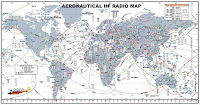Another great aspect of aviation monitoring takes place on shortwave radio. Over the open ocean, aircraft use HF frequencies to report their headings and altitudes to a worldwide network of shortwave-based control stations.
 |
| Worldwide HF aviation map. |
Generally speaking, the traditional VHF air band and its line-of-sight characteristic is good to about 100 miles offshore, then HF radio, satellite navigation and the ACARS positioning systems take over. Fortunately for shortwave listeners, the North Atlantic and Caribbean air routes still use radio as a primary means of communicating.
From my listening post in New England, the North Atlantic air route is the busiest and easiest to monitor. There are seven North Atlantic "tracks" (NATs) that accommodate flights between the U.S. and Europe - most of which are eastbound by night and westbound by day. Gander Oceanic Control (Gander Radio) in Newfoundland controls the western side, while Shanwick Control in Ireland keeps tabs on the European side.
Shortwave frequencies for the North Atlantic tracks are 2899 kHz, 5616 kHz, 8864 kHz, 13291 kHz and 17946 kHz. All transmissions are in USB and frequencies vary by time of day and propagation.
 |
| Photo courtesy of Flightaware.com |
Aircraft crossing the oceans must report in as they cross various points of longitude (called "waypoints") along each track, allowing controllers to maintain safe separation between planes. The ground controllers also receive SELCAL (selective calling) codes from the crew that allows the cockpit to be notified of incoming transmissions while leaving the radios muted.
Controllers also test the tones to make sure the radios activate properly. The website Code7700.com explains the history of SELCAL, which has been around for 60 years and adapted to the increasing amount of air traffic over the years.
Another important oceanic station is New York Radio, located in Ronkonkoma, New York, in the same building as New York Center, the regional VHF control facility. New York Radio controls a huge swatch of air space including the Gulf of Mexico, most of the Caribbean, parts of the NAT (zones 6 and 7) and part of the South Atlantic Tracks (SATs).
New York Radio's overseas "opposite" is Santa Maria Oceanic in Portugal, sharing these HF frequencies: 2962 kHz, 6628 kHz, 8825 kHz, 11309 kHz and 17946 kHz.
Much of the aviation electronics (avionics) for both military and civilian aircraft communications is manufactured by Rockwell-Collins of Cedar Rapids, Iowa. The company's line up of integrated HF radio and digital data equipment can be found here.
Finally, please enjoy this beautiful animation, depicting the thousands of flights that cross the Atlantic Ocean each day. Video is courtesy of Aerosavvy.com and Vimeo,com.

[quote]The ground controllers also assign SELCAL (selective calling) codes that allows cockpit crews to be notified of incoming transmissions while leaving the radios muted.[/quote]
ReplyDeleteSorry, the Selcal code is assigned to the aircraft when the HF radio is installed and never changes which is why it's permanently mounted on a placard in the cockpit.
Thanks Martin. I made the necessary edit to reflect this fact. Had to pull myself away from Gander Radio on 5616 for a few minutes.
Delete